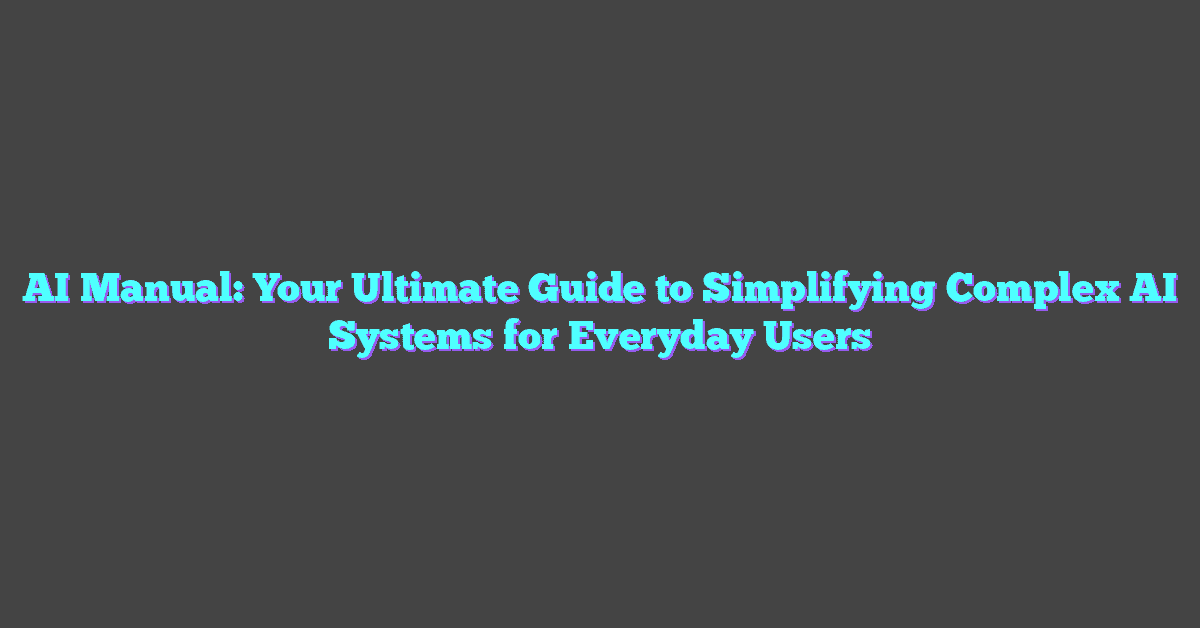Artificial Intelligence (AI) has become a buzzword in today’s tech-driven world, sparking imaginations and raising questions about its future. One intriguing question is whether AI can exist without human support. As machines become more advanced, the line between human and machine capabilities begins to blur, leading many to wonder if AI could eventually operate independently.
While the idea of self-sustaining AI sounds like science fiction, it’s worth exploring the current state of technology and the potential for future advancements. Can AI truly thrive without human intervention, or will it always need a guiding hand? This article delves into the fascinating discussion of AI’s autonomy and the role humans play in its development and sustainability.
Understanding AI Autonomy
AI autonomy refers to a machine’s ability to perform tasks without human intervention. This concept has garnered much attention as technology progresses, leading to debates about the limits and possibilities of self-sustaining AI.

Defining AI Independence
AI independence means that an AI system can operate, learn, and adapt without requiring continual human assistance. Examples include self-driving cars and autonomous drones. These systems leverage machine learning algorithms to make decisions based on data inputs, rather than direct programming for specific scenarios. To attain full independence, AI must handle unexpected situations, maintain its infrastructure, and evolve its knowledge base autonomously.
Historical Perspective on AI Development
The journey of AI began in the mid-20th century with early research in neural networks and symbolic reasoning. For decades, AI required detailed human programming and data input. Major milestones, such as IBM’s Deep Blue beating chess champion Garry Kasparov in 1997, showcased the growing sophistication of AI. In the 21st century, advancements in data availability and computational power led to breakthroughs like Google’s AlphaGo defeating Go champion Lee Sedol in 2016. Each landmark event demonstrated AI’s increasing capability to operate with minimal human intervention, though true independence remains a complex challenge.
Challenges in Autonomous AI
Achieving true AI autonomy requires addressing significant challenges. These hurdles revolve around energy management, self-maintenance, and error correction.
Energy Management
Robust energy management is crucial for autonomous AI. AI systems must manage power resources to ensure continuous operation. Without human intervention, these systems need advanced algorithms for efficient energy consumption. Examples include optimizing energy use during low-demand periods and harnessing renewable energy sources. Additionally, AI must adapt to energy fluctuations, avoiding system failures due to power issues.
Self-Maintenance and Error Correction
Self-maintenance and error correction are vital for sustained AI independence. Autonomous AI has to detect and resolve hardware and software malfunctions. Implementing real-time diagnostics minimizes downtime. Furthermore, AI systems require redundancy mechanisms to recover from critical failures. Examples include failover servers and automated software patches. These capabilities ensure the resilience and longevity of AI operations without human input.
The Role of Humans in AI Lifecycle
Humans play a crucial part in the AI lifecycle. From initial programming to continuous updates, human involvement ensures AI systems operate effectively and safely.
Initial Programming and Learning Models
Humans design initial programming and learning models for AI. They define algorithms and structures AI relies on to function. For instance, neural networks depend on human-crafted architectures. The training data, often curated by humans, provides the foundation AI uses to learn patterns. Without accurate, diverse data, AI’s performance can’t reach its full potential.
Ongoing Monitoring and Updates
Continuous human oversight is essential for AI. Professionals monitor AI systems to detect anomalies and biases. Regular updates, incorporating latest advancements and patches, maintain AI’s relevance and security. For example, updating databases with new information ensures AI models remain current and accurate. Human intervention guarantees AI adapts to changing environments and requirements.
Real-World Applications and Self-Sustaining AI
Real-world examples demonstrate current AI capabilities. Semi-autonomous systems highlight AI’s potential, while future advancements could lead to fully self-sustaining AI.
Cases of Semi-Autonomous AI Systems
Semi-autonomous AI systems already operate in various sectors. Autonomous vehicles, such as Tesla’s Autopilot, execute driving tasks with limited human supervision. Healthcare utilizes AI in diagnostic tools like IBM’s Watson, which provides insights but requires medical professionals for final decisions. In manufacturing, robotics automate repetitive tasks and optimize production efficiency.
Listing Example – Semi-Autonomous AI Usage:
- Autonomous Vehicles: Perform driving tasks, reduce driver workload.
- Healthcare Diagnostics: Assist doctors, improve diagnosis accuracy.
- Manufacturing Robotics: Automate tasks, increase production efficiency.
Potential for Fully Autonomous AI
Fully autonomous AI would function independently of human intervention. To achieve this, AI must overcome significant challenges such as self-maintenance, energy management, and evolving learning algorithms. Current research focuses on developing systems capable of self-optimization and real-time adaptation. While theoretical models and ongoing experiments explore these possibilities, practical implementation remains a future goal. Fully autonomous AI could revolutionize industries by operating with complete autonomy, leading to innovative solutions and unprecedented efficiency.
Ethical and Safety Concerns
Exploring ethical and safety concerns in AI is crucial for responsible development and deployment. These considerations ensure systems operate within moral boundaries and minimize risks.
Ethical Decision Making in AI
Ethical decision making in AI is complex as systems lack human judgment. Developers program AI with guidelines, but unpredictable situations can challenge these pre-defined rules. For instance, autonomous vehicles (AVs) deciding between causing minor injuries to multiple people or severe harm to one person. Addressing such dilemmas requires inclusive datasets and diverse programming teams to minimize bias.
Developers must ensure transparency in AI decision-making processes. Transparent algorithms help users understand and trust AI outcomes, increasing acceptance. Explainable AI (XAI) focuses on making machine decision processes visible and understandable to end-users.
Risk Management in Autonomous Systems
Risk management in autonomous systems is vital to prevent, identify, and mitigate potential failures. Developers create multiple layers of safety protocols to address system vulnerabilities. Fail-safes and shutdown mechanisms activate if AI systems detect abnormalities.
System redundancy enhances reliability. For example, AVs use multiple sensors (cameras, lidar) to cross-verify data, reducing the likelihood of sensor failure causing accidents. Continuous monitoring and updates are essential; regular system diagnostics and software updates help maintain functionality and security.
Collaboration with regulatory bodies ensures adherence to safety standards. Compliance with frameworks like ISO 26262 for AVs and FDA guidelines for AI in healthcare diagnostics demonstrates commitment to safety and ethical practices.
Conclusion
AI’s journey towards full autonomy is both fascinating and complex. While current applications show impressive capabilities, they still rely heavily on human oversight. The challenges of energy management, self-maintenance, and evolving learning algorithms highlight the need for ongoing human support.
Ethical and safety concerns remain at the forefront, with transparency and collaboration with regulatory bodies being crucial. As AI continues to evolve, balancing innovation with responsible development will be key to unlocking its full potential.
Frequently Asked Questions
What is AI autonomy?
AI autonomy refers to the ability of artificial intelligence systems to operate independently without human intervention. These systems can make decisions and execute tasks on their own, relying on advanced algorithms and data inputs.
Why is human involvement important in AI development?
Human involvement is crucial in AI development to ensure ethical considerations, accuracy, and safety. Humans guide the AI lifecycle by setting objectives, conducting oversight, and addressing challenges like bias and errors, thus maintaining reliable and responsible AI systems.
What are the challenges of managing energy and self-maintenance in AI systems?
AI systems require significant computational power, leading to high energy consumption. Additionally, self-maintenance involves ensuring the AI remains functional and up-to-date without human intervention, which is complex and demands sophisticated monitoring and repair mechanisms.
Can you provide examples of real-world applications of AI?
AI is used in various fields, such as semi-autonomous vehicles for safer transportation, healthcare diagnostics for quicker and accurate disease detection, and manufacturing robotics that enhance productivity and precision in production lines.
What does fully autonomous AI entail?
Fully autonomous AI operates entirely independently from human intervention, handling tasks like self-maintenance and continuous learning. It evolves by adapting its algorithms and reacting to new information, although this poses significant technical and ethical challenges.
What are the ethical and safety concerns in AI development?
Ethical concerns include ensuring fairness, preventing bias, and securing privacy. Safety concerns involve making AI systems reliable and preventing harmful actions. Responsible AI development balances innovation with these ethical and safety considerations.
Why is transparency in AI processes important?
Transparency, achieved through Explainable AI (XAI), ensures that AI decisions and processes are understandable to humans. This accountability helps build trust, allows for error identification, and ensures ethical adherence in AI operations.
How do regulatory bodies contribute to AI safety?
Regulatory bodies establish safety standards and guidelines for AI development and deployment. Collaboration with these bodies ensures that AI technologies comply with legal and ethical norms, fostering safe and responsible innovation.
What is the role of Explainable AI (XAI)?
Explainable AI (XAI) aims to make AI decision processes transparent and understandable. XAI helps users comprehend how AI systems reach conclusions, promoting trust, accountability, and better management of AI risks.
How can AI maintain its learning capabilities?
AI systems can maintain learning capabilities through continuous algorithm updates and integrating new data. This requires robust frameworks and monitoring to ensure AI adapts accurately and remains effective over time.




